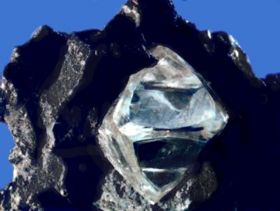Diamond
 From Conservapedia
From Conservapedia | Diamond | |
|---|---|

| |
| Chemical name | Carbon |
| Chemical formula | C |
| Identification | |
| Birefringence | None |
| Colors | Colorless. Impurities may produce pink, yellow, brown |
| Crystal habit | Octahedral |
| Crystal system | Cubic |
| Cleavage | Perfect in four directions |
| Dispersion | 0.044 |
| Fracture | Conchoidal - step like |
| Hardness | 10 |
| Luster | Adamantine |
| Name origin | Ancient Greek adamas - "invincible". |
| Optics | Singly refractive |
| Pleochroism | None |
| Specific gravity | 3.52 |
| Spectral | In pale yellow stones a 415.5 nm line is typical. Irradiated and annealed diamonds often show a line around 594 nm when cooled to low temperatures. |
| Streak | Colorless |
Diamond is an allotrope of carbon, and can be formed when carbon atoms are arranged in a tetrahedral fashion when put under immense amounts of heat and pressure. Diamonds are created in the Earth's mantle, due to forces and heat required for their creation, and are sometimes brought near the surface through volcanic eruption.
Diamonds are also noted for being the hardest natural material on the Mohs Scale, and fairly rare (deposits are found in Kimberlite in South Africa). As such, natural diamonds are used for jewelry, and synthetic diamonds for drill bits.
Diamond is the traditional stone for engagement rings, and is the birthstone for April.
Most of the diamond trade of the world is controlled by De Beers, a South African company which uses its near-monopoly to keep the price of diamonds high. Actually diamonds are common within the surface of the Earth, and if it was not for De Beers they would be quite cheap.[Citation Needed]
In modern times artificial diamonds can be created. They are used for cheap jewellery and in electronics and cars. In the future it may be possible to use diamonds as a construction material, since carbon is plentiful and cheap.[Citation Needed]
External links[edit]
- Minelinks.com - Diamonds
- About-birthstones.com - April birthstone
Categories: [Birthstones] [Gems] [Luxury]
↧ Download as ZWI file | Last modified: 02/15/2023 22:20:26 | 86 views
☰ Source: https://www.conservapedia.com/Diamond | License: CC BY-SA 3.0
 ZWI signed:
ZWI signed: KSF
KSF